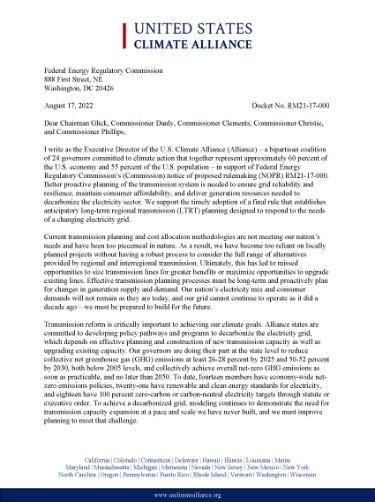Home / U.S. Climate Alliance Supports Improved Long-Term Regional Transmission Planning from FERC
- Letter
U.S. Climate Alliance Supports Improved Long-Term Regional Transmission Planning from FERC
August 17, 2022
Better proactive planning of the transmission system is needed to ensure grid reliability and resilience, maintain consumer affordability, and deliver generation resources needed to decarbonize the electricity sector. We support the timely adoption of a final rule that establishes anticipatory long-term regional transmission (LTRT) planning designed to respond to the needs of a changing electricity grid.
Current transmission planning and cost allocation methodologies are not meeting our nation’s needs and have been too piecemeal in nature. As a result, we have become too reliant on locally planned projects without having a robust process to consider the full range of alternatives provided by regional and interregional transmission. Ultimately, this has led to missed opportunities to size transmission lines for greater benefits or maximize opportunities to upgrade existing lines. Effective transmission planning processes must be long-term and proactively plan for changes in generation supply and demand. Our nation’s electricity mix and consumer demands will not remain as they are today, and our grid cannot continue to operate as it did a decade ago — we must be prepared to build for the future.
About the Alliance
Launched on June 1, 2017 by the governors of Washington, New York, and California to help fill the void left by President Trump’s initial decision to withdraw the U.S. from the Paris Agreement, the Alliance has grown to include 24 governors from across the U.S. representing approximately 60% of the U.S. economy and 55% of the U.S. population. Governors in the Alliance have pledged to collectively reduce net greenhouse gas emissions by at least 26-28% by 2025, 50-52% by 2030, and 61-66% by 2035, all below 2005 levels, and collectively achieve overall net-zero greenhouse gas emissions as soon as practicable, and no later than 2050.
The Alliance’s states and territories will continue to advance innovative and impactful climate solutions to grow the economy, create jobs, and protect public health, and have a long record of action and results. In fact, the Alliance reduced its collective net greenhouse gas emissions by 19% between 2005 and 2022, while increasing collective GDP by 30%, and is on track to meet its near-term climate goal by reducing collective GHG emissions 26% below 2005 levels by 2025. The coalition’s states and territories are employing more workers in the clean energy sector, achieving lower levels of dangerous air pollutants, and preparing more effectively for climate impacts and executing more pre-disaster planning than the rest of the country.
###
